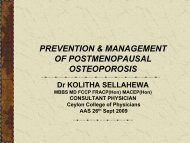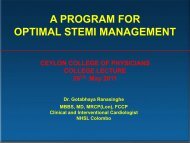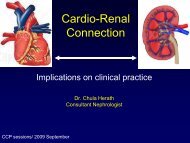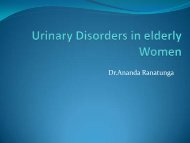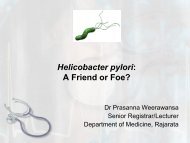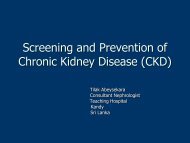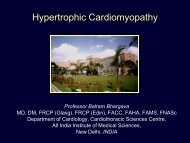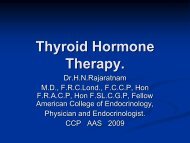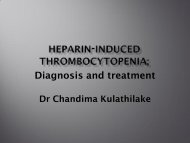A Practical Approach to Syncope
A Practical Approach to Syncope
A Practical Approach to Syncope
Create successful ePaper yourself
Turn your PDF publications into a flip-book with our unique Google optimized e-Paper software.
A <strong>Practical</strong> <strong>Approach</strong> <strong>to</strong> <strong>Syncope</strong>Dr. Rohan GunawardenaConsultant Cardiac ElectrophysiologistNational Hospital of Sri Lanka
Definition• Transient loss of consciousness due <strong>to</strong> a globalreduction in cerebral blood flow.– Rapid onset– Very short duration– Loss of postural <strong>to</strong>ne– Spontaneous and complete recovery
Exclusions• Conditions with LOC but no global cerebralhypoperfusion– Epilepsy– Hypoglycaemia, hypoxia, hyperventilation withhypercapnia– In<strong>to</strong>xication– Vertibrobasilar TIA• Other disorders that mimic LOC– Cataplexy– Drop attacks, falls– Carotid circulation TIAs– psycogenic
Causes of true syncope• Neuro-cardiogenic (Reflex) syncope– Vasovagal– Situational– Carotid sinus– Atypical form• Orthostatic (hypotensive)– Iry au<strong>to</strong>nomic failure– IIry au<strong>to</strong>nomic failure– Drug induced– Volume depletionDue <strong>to</strong> impaired sympathetic efferent activityDue <strong>to</strong> inappropiate function of reflexes thatand/or reduced venous returnmaintain BP in the upright posture leading <strong>to</strong>• Iry Cardiac ANF – multiple system atrophy, purehypotension (vasodeppressor) or bradycardiaau<strong>to</strong>nomic • Bradyarrhythmias failure, Lewy – SSS body or CHB dementia, ass.(cardioinhibi<strong>to</strong>ry)with •Tachy Parkinsons arrythmias – VT, SVT with LVVasovagal – prolonged standing/sitting,• IIry dysfunction, ANF – DM, AVNRT, amyloidosis, WPW ureamiaemotion, pain, blood.• Drug • Structural induced abnormalities – vasodila<strong>to</strong>rs, – AS, diuretics, MS, HOCM,Situational – cough, micturition, GI– Postural orthostatic tachycardia syndrome phenothiazines, Ischaemic/Dilated (POTS) antidepressantsCardiomyopathiesstimulation, laughing• Volume depletion – diorrhoea, vomitingCarotid sinus – hypersensitivity• POTS - ?inadequate venous return, excessiveAtypical – uncertain, absent triggersblood pooling• Cardiac– Brady-arrhythmias– Tachy-arrhythmias– Structural abnormalitiesNeurocardiogenicOrthostaticsyncope
Pre-syncope ↔ <strong>Syncope</strong>?
Tools in evaluating <strong>Syncope</strong>• His<strong>to</strong>ry• His<strong>to</strong>ryHISTORY• His<strong>to</strong>ry• Examination• Investigations• Is it true syncope• Is there a clue <strong>to</strong> theaetiology• Is there evidence ofhigh risk
Hx of syncope episodeLatest episode• Time of episode• Posture and Situation• Pre-syncope symp<strong>to</strong>ms• <strong>Syncope</strong> description• RecoveryPrevious episodes
Case Hx 112 yr old girlEpisode of fainting in the morning duringassembly at school. She had started sweating,vision became blurred and friends said shebecame pale. Had collapsed on<strong>to</strong> the floor butrecovered immediately. Perfectly normal afterrecovery. Two previous episodes, once in Sundayschool while taking ‘pan sil’ and the other on theway back from school standing in a crowded bus.
• Time of episode– Early morning• VVS– Relationship with diet• DM– Medications• Anti-HT• Diabetic– Psychogenic– At night• Arrhythmias
Posture and situation– Sitting/standing at rest• Vasovagal– Supine• Arrhythmic• Epilepsy– During activity• Arrhythmic• Structural heart dis.
Posture and situation cont.• Emotional stress, fear, blood.– VVS• After exercise– Some arrhythmias (VT, SVT)• Warm, crowded places– VVS• Sudden change in posture– Au<strong>to</strong>nomic failure– Carotid sinus syncope
• Case Hx 2• 62 yr old man• Rx in ICU for renal impairment andpneumonia• Short episode of syncope withdocumented asys<strong>to</strong>le• R Carotid massage at bedside showedlong sinus pause
Preceding symp<strong>to</strong>ms• Palpitations– VT, SVT• Headache, pallor, blurring of vision– VVS• Aura, lip smacking– epilepsy
Case Hx 3• 73 yr old woman• Repeated episodes of syncope lasting up<strong>to</strong> I minute• Preceded by palpitations• Holter runs of AF followed by long sinuspauses• EP study showed SSS
During syncope• Tonic clonic movements– epilepsy• Floppy– VVS• Tongue biting– Epilepsy• Incontinence– epilepsy• Injury– Risk assessment• Duration
Case Hx 4• 56 yr old man• <strong>Syncope</strong> during meeting• Lasted until reaching hospital – 20 minutes
Recovery• Spontaneous and complete– Reflex syncopes– Arrhythmias• Sleepy, loss of memory– Epilepsy
• AgeOther (relevant) Hx
VVSStructural HDAu<strong>to</strong>nomic failureDrug inducedBrady-arrhythmias
Other (relevant) Hx• Age• Chest pain• Diabetes, IHD• Anti-hypertensives, anti psychotic• Impotence• Family Hx of SCA/SCD
Case Hx 5Episode of <strong>Syncope</strong>young• 32 yr old female executive• On a flight back from UK (UL), one hour beforelanding• Not got up from seat.• Not eaten much or drunk water• Several glasses of wine during flight• On Nicardia for hypertension• Highly positive Tilt testlongperiodofsittingVasodilatationDehydration
Examination• Cardiac murmurs• CNS exam• Carotid sinus massage• Orthostatic BP measuring• Injuries
After Hx & ExDefinite <strong>Syncope</strong>• Very sure of cause• Have certain pointers• Have no idea at allNot True <strong>Syncope</strong>Treat/referappropriatelyECG2D Echo
InvestigationsECG• bradycardia/conduction defects• WPW• evidence of IHD• VEs• Brugada synd/LQT/SQT
InvestigationsEchocardiogram• AS/MS• HCM• DCM
InvestigationsTrue syncopeAppropriate RxAppropriate IxsECGEchoReflex syncope orOrthostaticHypotension
InvestigationsTruesyncopeAppropriate RxAppropriate IxsECGEchoReflexsyncope/orthostatichypotensionHUTT/ActivestandingRx appropriately
Ix for Reflex <strong>Syncope</strong>Head up tilt test (HUTT)• Tilting <strong>to</strong> a semi-erect position (70 0 ) after a period ofsupine rest.• Carotid sinus massage done while tilted• Blood pooling and ↓ venous return caused byorthostatic stress• Leads <strong>to</strong> sympathetic withdrawal and vagal overactivity• Causing hypotension and bradycardia• Sensitivity 70% and specificity 90%• Classically positive in VVS and in other reflex syncopes• Can also be positive in SSS
Carotid massage
Ix for Orthostatic HypotensionActive standing• Supine BP and frequent BP measurements up<strong>to</strong> 3 min – 30 min• Positive if fall in syst. BP >20mmHg or diast.>10mmHg or Syst.
InvestigationsTruesyncopeAppropriate RxAppropriate IxsECGEchoHUTT/ActivestandingReflexsyncope/orthostatichypotensionRx appropriately? arrhythmia1. Holter/loop recorder2. Ex ECG3. EP study
Ix for suspected arrhythmia• 24hr/48hr Holter– Frequent episodes• Loop recorders (external)– Less frequent symp<strong>to</strong>ms• Implantable loop recorders– Gold standard Ix• Exercise ECG– Exercise induced syncope• EP study– Suspicion of a brady arrhythmia – Brady study– Evaluation of syncope in Cardiomyopathies/Brugada –VT stim
Bradycardiastudy
InvestigationsTruesyncopeAppropriateRxAppropriateIxsECGEchoReflexsyncope/orthostatichypotension1. Holter/looprecorder2. Ex ECG3. EP study? arrhythmiaHUTT/ActivestandingRxappropriatelyUncertainCertain diganosisRx
InvestigationsTruesyncopeAppropriateRxAppropriateIxsECGEchoReflexsyncope/orthostatichypotensionUncertain1. Holter/looprecorder2. Ex ECG3. EP study? arrhythmiaHUTT/ActivestandingRxappropriatelyUncertainCertain diganosisRx
UncertaindiagnosisHigh riskLow risk – 1-2 episodesLow risk -frequentEarly Ix/RxNo further IxRe-analyse HxTargeted IxsImplantable loop recorder
High Risk Patients who may need admissionand early electrophysiological evaluationThose with possible tachy-arrhythmias• <strong>Syncope</strong> during exertion or supine• Palpitations during syncope• Frequent VEs or NSVT• Pre-excited QRS complexes• Short or long QT intervals, Brugada pattern ECG• Family Hx of SCDThose with possible brady-arrhythmias• PR prolongation, Bi fascicular block, Intraventricular conduction defects(QRS>120ms)• Sinus bradycardia (< 50bpm) or sinoatrial blockEvidence of Coronary artery Dis, or Severe sructural Ht. Dis.• Hx of MI, Angina• Clinical evidence of Ht. failure or low EF on echo
Take home messages• His<strong>to</strong>ry is the most important <strong>to</strong>ol indiagnosing the aetiology of syncope(diagnoses up <strong>to</strong> 50%)• Targeted investigations are helpful inconfirming a diagnosis• Those patients at high risk need early Ix andRx
Case Hx 6• 68 year old women• Hx of syncope on 4 occasions during the last 3years• Gamut of Ix including EEG, CT, MRI• Admitted for in ward moni<strong>to</strong>ring• Moni<strong>to</strong>r showed CHB escape rhythm of





